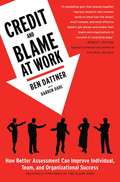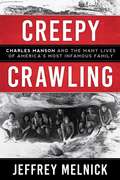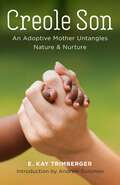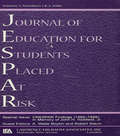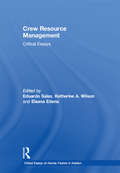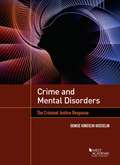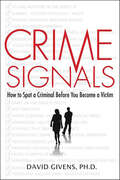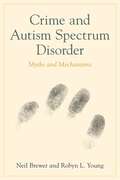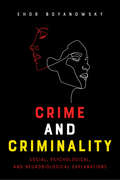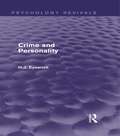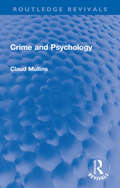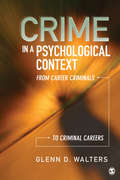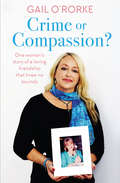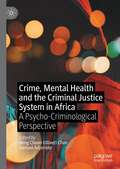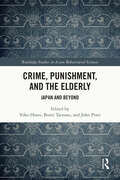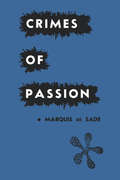- Table View
- List View
Credit and Blame at Work: How Better Assessment Can Improve Individual, Team and Organizational Success
by Ben DattnerPreviously published as The Blame Game, this acclaimed guide by a leading workplace expert offers essential advice about how to succeed at work by avoiding the pitfalls of pervasive credit-grabbing and finger-pointing.Credit and Blame at Work, praised by bestselling management expert Robert Sutton as “a modern management classic; one of the most well-crafted business books I have ever read,” psychologist and workplace consultant Ben Dattner reveals that at the root of the worst problems at work is the skewed allocation of credit and blame. It’s human nature to resort to blaming others, as well as to take more credit for successes than we should. Many managers also foster a “blame or be blamed” culture that can turn a workplace into a smoldering battlefield and upend your career. Individuals are scapegoated, teams fall apart, projects get derailed, and people become disengaged because fear and resentment take hold. But Dattner shows that we can learn to understand the dynamics of this bad behavior so that we can inoculate ourselves against it. In lively prose, Dattner tells a host of true stories from individuals and teams he’s worked with, identifying the eleven personality types who are especially prone to credit and blame problems and introducing simple methods for dealing with each of them. The rich insights and powerful practical advice Dattner offers allow readers to master the vital skills necessary for rising above the temptations of the blame game, defusing the tensions, and achieving greater success.
Creepy Crawling: Charles Manson and the Many Lives of America's Most Infamous Family
by Jeffrey Melnick"Creepy crawling" was the Manson Family's practice of secretly entering someone's home and, without harming anyone, leaving only a trace of evidence that they had been there, some reminder that the sanctity of the private home had been breached. Now, author Jeffrey Melnick reveals just how much the Family creepy crawled their way through Los Angeles in the sixties and then on through American social, political, and cultural life for close to fifty years, firmly lodging themselves in our minds. Even now, it is almost impossible to discuss the sixties, teenage runaways, sexuality, drugs, music, California, and even the concept of family without referencing Manson and his "girls." Not just another history of Charles Manson, Creepy Crawling explores how the Family weren't so much outsiders but emblematic of the Los Angeles counterculture freak scene, and how Manson worked to connect himself to the mainstream of the time. Ever since they spent two nights killing seven residents of Los Angeles-what we now know as the "Tate-LaBianca murders"-the Manson family has rarely slipped from the American radar for long. From Emma Cline's The Girls to the recent TV show Aquarius, the family continues to find an audience. What is it about Charles Manson and his family that captivates us still? Author Jeffrey Melnick sets out to answer this question in this fascinating and compulsively readable cultural history of the Family and their influence from 1969 to the present.
Creole Son: An Adoptive Mother Untangles Nature and Nurture
by E. Kay TrimbergerCreole Son is the compelling memoir of a single white mother searching to understand why her adopted biracial son grew from a happy child into a troubled young adult who struggled with addiction for decades. The answers, E. Kay Trimberger finds, lie in both nature and nurture. When five-day-old Marco is flown from Louisiana to California and placed in Trimberger’s arms, she assumes her values and example will be the determining influences upon her new son’s life. Twenty-six years later, when she helps him make contact with his Cajun and Creole biological relatives, she discovers that many of his cognitive and psychological strengths and difficulties mirror theirs. Using her training as a sociologist, Trimberger explores behavioral genetics research on adoptive families. To her relief as well as distress, she learns that both biological heritage and the environment—and their interaction—shape adult outcomes. Trimberger shares deeply personal reflections about raising Marco in Berkeley in the 1980s and 1990s, with its easy access to drugs and a culture that condoned their use. She examines her own ignorance about substance abuse, and also a failed experiment in an alternative family lifestyle. In an afterword, Marc Trimberger contributes his perspective, noting a better understanding of his life journey gained through his mother’s research. By telling her story, Trimberger provides knowledge and support to all parents—biological and adoptive—with troubled offspring. She ends by suggesting a new adoption model, one that creates an extended, integrated family of both biological and adoptive kin.
Crespar Findings (1994-1999): In Memory of John H. Hollifield. A Special Double Issue of the journal of Education for Students Placed at Risk
by A. Wade Boykin Robert SlavinThis double issue presents summaries of the scholarly and practical-reform accomplishments of the first five years of the Center for Research on the Education of Students Placed at Risk (CRESPAR). This bold, five-year initiative addressed several of the problems that most directly challenge the values and practical aspirations of modern democracies. The included articles emphasize how CRESPAR has focused on the schools in many of America's most challenging communities. It has both helped local schools improve themselves and advanced the nation's research base. This issue was written in commemoration of the life and work of John Henry Hollifield, Jr., founding coeditor. For 28 years, Hollifield served as an editor and administrator at Johns Hopkins University's Center for Social Organization of Schools. When JESPAR was just an idea, Hollifield was one of the people who most strongly advocated its development. He had a ready smile, a fine editorial touch, and a relentless will to produce each excellent issue. This issue, summarizing much of the research from CRESPAR's first five years, is presented by the full team of authors in his loving memory.
Crew Resource Management: Critical Essays (Critical Essays on Human Factors in Aviation)
by Eduardo Salas, Katherine A. Wilson and Eleana EdensCrew Resource Management (CRM) training was first introduced in the late 1970s as a means to combating an increased number of accidents in which poor teamwork in the cockpit was a significant contributing factor. Since then, CRM training has expanded beyond the cockpit, for example, to cabin crews, maintenance crews, health care teams, nuclear power teams, and offshore oil teams. Not only has CRM expanded across communities, it has also drawn from a host of theories from multiple disciplines and evolved through a number of generations. Furthermore, a host of methodologies and tools have been developed that have allowed the community to better study and measure its effect on team performance and ultimately safety. Lacking, however, is a forum in which researchers and practitioners alike can turn to in order to understand where CRM has come from and where it is going. This volume, part of the 'Critical Essays on Human Factors in Aviation' series, proposes to do just that by providing a selection of readings which depicts the past, present, and future of CRM research and training.
Crime And Mental Disorders: The Criminal Justice Response (Higher Education Coursebook)
by Denise Gosselin<p>The newest entry in the cutting edge topic of Mental Illness and Crime, this book from Denise Gosselin is practically focused and straightforward in its approach. It's clear, concise writing style avoids jargon and will engage both undergraduate and graduate students. It includes discussions of understanding mental illness, the changing landscape of criminal justice and mental illness, criminal justice responses to mental illness, alternatives to incarceration and global issues. An accompanying website includes Test Banks and other instructional materials. <p>Organized into five sections: <p> <li>Part I UNDERSTANDING MENTAL ILLNESS concern the history (past and present), classifications, and introduction to the criminal justice issues on the responses to people with mental illness. <li>Part II THE CHANGING LANDSCAPE examines the criminal justice involved encounters that occur outside of the traditional system, involving intervention, collaboration, and civil commitment. <li>Part III CRIMINAL JUSTICE RESPONSES look at law and policy of law enforcement, the criminal court and corrections. <li>Part IV ALTERNATIVES TO INCARCERATION reflects recent changes to reentry and community corrections. The juvenile justice component includes the brief system responses to juveniles with mental disorders. <li>Part V GLOBAL ISSUES stands alone as chapter 14 to remind us that we are not alone! The issues and system responses are not unique to the United States. </li> </p>
Crime Classification Manual
by John Douglas Robert K. Ressler Ann W. Burgess Allen G. BurgessPraise for Crime Classification Manual"The very first book by and for criminal justice professionals in the major case fields. . . . The skills, techniques, and proactive approaches offered are creatively concrete and worthy of replication across the country. . . . Heartily recommended for those working in the 'front line' of major case investigation."-John B. Rabun Jr., ACSW, Executive Vice President and Chief Operating Officer, National Center for Missing and Exploited Children"[CCM] is an outstanding resource for students pursuing forensic science degrees. It provides critical information on major crimes, which improve the user's ability to assess and evaluate."-Paul Thomas Clements, PhD, APRN-BC, CGS, DF-IAFN Drexel University Forensic Healthcare ProgramThe landmark book standardizing the language, terminology, and classifications used throughout the criminal justice systemArranged according to the primary intent of the criminal, the Crime Classification Manual, Third Edition features the language, terms, and classifications the criminal justice system and allied fields use as they work to protect society from criminal behavior.Coauthored by a pioneer of modern profiling and featuring new coverage of wrongful convictions and false confessions, the Third Edition:Tackles new areas affected by globalization and new technologies, including human trafficking and internationally coordinated cybercrimesExpands discussion of border control, The Bureau of Alcohol, Tobacco, Firearms and Explosives (ATF), and Homeland SecurityAddresses the effects of ever-evolving technology on the commission and detection of crimeThe definitive text in this field, Crime Classification Manual, Third Edition is written for law enforcement personnel, mental health professionals, forensic scientists, and those professionals whose work requires an understanding of criminal behavior and detection.
Crime Signals: How to Spot a Criminal Before You Become a Victim
by David GivensCrime is never unpredictable. Before a lie is spoken, a pocket is picked, or an assault is inflicted, each and every criminal gives off silent cues. They can be as subtle as a shrug of the shoulder, a pointed finger, or an averted gaze. But together, they make up a nonverbal language that speaks loud and clear—if you're trained to see it. CRIME SIGNALS is the first book to offer a comprehensive guide to the body language of criminals. Filled with amazing real-life stories of crime and survival, it's designed to help you stay alert to the warning signs of a wide array of offenses. From the tell-tale signals of a swindler to the warning signs that experts use to help thwart terrorism and violent crime, this book breaks down a criminal's body language into clear recognizable symbols.What is the look of a lie? How do child predators unknowingly give themselves away? What were the clues that exposed white-collar offenders like Martha Stewart and Andrew Fastow? Answering these questions and more, Dr. David Givens, a renowned anthropologist and one of the nation's foremost experts in nonverbal communication, offers a fascinating, instructive, and essential tool for warding off crime and protecting the safety or yourself and your family.
Crime Victims with Developmental Disabilities: Report of a Workshop
by National Research CouncilA report on Crime Victims with Developmental Disabilities
Crime and Autism Spectrum Disorder: Myths and Mechanisms
by Neil Brewer Robyn Louise YoungHaving Autism Spectrum Disorder (ASD) can - given certain situational conditions - make individuals more vulnerable to becoming caught up in criminal activity and vulnerable to unfavourable interactions once in the criminal justice system. Guided by empirical research, psychological theory and illustrative case studies involving adults with ASD who have been implicated in crimes, Robyn L. Young and Neil Brewer explain why. They examine the pivotal cognitive, social and behavioural characteristics unique to ASD (such as weak Theory of Mind, restricted interests and acute sensory sensitivities) that - individually or in interaction - may contribute to individuals becoming involved in illegal activities. They then discuss how these same characteristics can result in ongoing ineffective interaction with the criminal justice system. Arguing that the forensic assessment of individuals with ASD requires substantial redevelopment to clarify the key deficits contributing to criminal behaviour, the authors highlight the need for, and desirable nature of, intervention programs to minimize the criminal vulnerability of adults with ASD and to prepare them for interactions with the criminal justice system. A final section raises some major unanswered questions and issues for future research. This book will be of immeasurable interest to criminal justice professionals including probation officers, social workers, clinical and forensic psychologists, police officers, lawyers and judges, as well as students of these professions.
Crime and Crime Reduction: The importance of group processes
by Theresa A. Gannon Jane L. WoodThe problems associated with groups that commit crime are well known and notoriously complex. However, there are many questions that we still cannot answer with certainty. This book seeks to deepen understanding of the group processes involved in crime and the treatment of offenders’ thoughts and behaviour. Together, the chapters in this volume address the following questions: Are people more likely to commit crime because of the influence of their group? Does group membership cause people to become criminals, or does the group merely foster people’s pre-existing criminal inclinations? How does group membership exert such a strong hold on people so that some risk imprisonment or even death, rather than relinquish their membership? The contributors to Crime and Crime Reduction consider the social psychological influences of groups and specific forms of group crime such as street and prison gangs, terrorism, organized criminal networks, and group sexual offending. The book also addresses important questions about the role of groups in treating offenders, and why existing group membership should be considered when treating offenders. Group criminal activity is a key area of study for researchers and for students of Forensic Psychology and Criminology courses. This book will therefore be of interest to students, scholars, and law enforcement practitioners who want to understand the group processes involved in crime and its reduction.
Crime and Criminality: Social, Psychological, and Neurobiological Explanations
by Ehor BoyanowskyThis informative and entertaining book, peppered with personal anecdotes, and rich in case studies, adopts an eclectic approach to studying the causes of crime. Rather than rely on one theoretical position, Boyanowsky opts to borrow from a variety of theories to arrive at the most effective answer. As a result, even seasoned veterans will learn from this book. Crime and Criminality employs case studies, both notorious and lesser known, to bring theories to life, and to offer insight into vital contemporary topics like domestic violence, child pornography, genocide, the effect of climate change on crime, and the evolution of cybercrime. Entertaining, and accessible, and comparative in scope, this text is ideal for students and general readers interested in understanding the varied causes of crime. Instructor supports in the form of PowerPoint slides as well as introductions, and summaries for each chapter make this an ideal text for criminology courses.
Crime and Personality (Psychology Revivals)
by H.J. EysenckWhen Crime and Personality was first published in 1964, J.A.C. Brown, writing in the New Statesman, commented: ‘There can be no doubt of the importance of Professor Eysenck’s book on the nature and treatment of criminal behaviour.’ This third edition, originally published in 1977, had been completely revised and brought up to date, and although the major theory linking personality and crime has been retained, many of the details have been changed in conformity with recent research of the time. The book presents a theory concerning the personality of criminals, and offers evidence to show that these personality features characterising criminals are based on genetic foundations. It is argued that criminality as a whole is not exclusively based on environmental factors as has so often been suggested, but has a strong biological basis. A good deal of evidence is reviewed showing that there are many data supporting this view, from studies of identical and fraternal twins, adopted children, and comparisons between criminals and non-criminals both in the Western world and in Communist countries. Professor Eysenck suggests that important consequences follow from such an attempt to redress the one-sided emphasis on environmental factors which had been so characteristic of the previous fifty years, and some of these consequences are described in detail. He further suggests that only proper understanding of the psychological factors making for antisocial behaviour will help in reversing the increasing burden that criminality places upon society. The book also takes issue with political arguments of the time regarding the origins of criminality, and shows that criminals behind the Iron Curtain show the same personality characteristics as do criminals in Western countries.
Crime and Psychology (Routledge Revivals)
by Claud MullinsFirst published in 1943 Crime and Psychology reveals to the public some of the results of well-known magistrate Claud Mullin’s many years of pioneering work in using the help of medical psychologists for the treatment of criminals. The book contains numerous actual cases of real scientific and social value. They show how even men who have in the past been sent to prison for serious offences can be helped, through treatment while at liberty, to lead useful lives for many years afterwards. The author also shows how psychological principles could become essential features of our system of criminal trial. This constructive and convincing book is an essential read for scholars and researchers of criminal psychology, applied psychology, criminology, and psychology in general.
Crime and Psychology: Foundations of Forensic Practice
by Jonathan VennClear and accessible in style, this book offers a comprehensive introduction to criminal justice and forensic mental health and the ways in which they intersect. Assuming no prior exposure to the field of criminal forensic psychology, the book reviews ten areas where mental health professionals contribute regularly to the due process of law: comprehension of rights, competency to stand trial, transfer of juveniles to adult court, risk assessment, mitigation, sentencing, sexually violent predators, insanity, and capital punishment of persons with mental illness and with intellectual disability. The book also explores the major categories of mental disorders, how they contribute to criminal behavior, and what problems they present in courts and corrections. Landmark cases from the United States and United Kingdom are also reviewed in detail to develop a thorough understanding of the court’s decision-making process. Bridging the gap between abstraction and practice through its narrative presentation of case material, emphasis on controversy, and illumination of the historical roots of problems and ideas, the book helps the forensic practitioner transition from novice to knowledgeable professional in the courtroom. Drawing on the author’s extensive experience in forensic psychology, this book is the ideal resource for the early-career forensic mental health practitioner, as well as graduate students in forensic mental health and forensic psychology, and mental health professionals seeking to enter the field of forensics.
Crime as Destiny: A Study of Criminal Twins (Psychology Revivals)
by Johannes LangeFirst published in 1931, Crime as Destiny throws a beam of light across the darkness which enshrouds the study of the deeper causes of crime and the eternal debate between nature versus nurture. The author’s investigations led him to conclusions of the first importance to the sociologist and the psychologist. But the subject is wilder than it seems and by its direct bearing on the question of determinism will arouse the interest of the theologian and the student of philosophy as well. For the student of history, this research work will help trace the beginning of the logic of eugenics that will eventually take its nightmarish form under Hitler.
Crime in Japan: A Psychological Perspective (Palgrave Advances in Criminology and Criminal Justice in Asia)
by David P. Farrington Laura BuiThis book reviews research on psychology and crime in Japan, and compares the findings with similar research conducted in Western industrialised countries. It examines explanations for crime and antisocial behaviour in Japan using research and theories from a psychological perspective. Topics covered include cultural explanations, developmental and life-course criminology, family violence and family risk factors, youth crime and early prevention, school factors and bullying, mental disorders, biosocial factors, psychopathy and sexual offending. In some parts, it challenges and refines the prevailing belief that Japan is a society characterised by low crime and little antisocial behaviour. This original project is the most up-to-date work on crime in Japan, and advances the important field of psychological criminology.
Crime in Japan: A Psychological Perspective (Palgrave Advances in Criminology and Criminal Justice in Asia)
by David P. Farrington Laura BuiThis book reviews research on psychology and crime in Japan, and compares the findings with similar research conducted in Western industrialised countries. It examines explanations for crime and antisocial behaviour in Japan using research and theories from a psychological perspective. Topics covered include cultural explanations, developmental and life-course criminology, family violence and family risk factors, youth crime and early prevention, school factors and bullying, mental disorders, biosocial factors, psychopathy and sexual offending. In some parts, it challenges and refines the prevailing belief that Japan is a society characterised by low crime and little antisocial behaviour. This original project is the most up-to-date work on crime in Japan, and advances the important field of psychological criminology.
Crime in a Psychological Context: From Career Criminals to Criminal Careers
by Glenn D. WaltersThis engaging book presents a contextual psychological interpretation of crime. It covers essential topics including psychopathy, antisocial personality disorder, and criminal lifestyle. The author's compelling analysis explains criminal behavior, by showing how the criminal lifestyle is capable of integrating two seemingly incompatible crime paradigms: the career criminal paradigm and the criminal career paradigm. Starting with a context for criminality, and then moving from particular conceptions of crime to more evidence-based theories, this volume challenges students to think in a different way about crime and criminal behavior.
Crime or Compassion?: One woman's story of a loving friendship that knew no bounds
by Gail O'Rorke'I was torn. My best friend needed me. But little did I know then what the consequences of helping her would be...'In 2015, Gail O'Rorke stood trial on three counts of assisting in the suicide of her friend Bernadette Forde, who had taken her life in 2011 in the late stages of Multiple Sclerosis. Facing the possibility of fourteen years in prison for a crime she didn't commit, Gail was also grieving for the friend she'd lost.Here in Crime or Compassion? she takes us on the journey behind the events that led to her arrest: from her remarkable early years - growing up with an abusive father and her escape to a better life - to her enduring friendship with Bernadette and the highs and lows of caring for someone you love, to the moment she was arrested by Garda officers, signalling three of the worst years of her life.This is a story of friendship and selflessness, of the rules of a society sometimes at odds with the nature of personal suffering, and a gripping insight into the inner world of the courtroom: the characters, the colour, and the emotions that accompany standing in the dock, facing a jury of your peers.
Crime or Compassion?: One woman's story of a loving friendship that knew no bounds
by Gail O'Rorke'I was torn. My best friend needed me. But little did I know then what the consequences of helping her would be...'In 2015, Gail O'Rorke stood trial on three counts of assisting in the suicide of her friend Bernadette Forde, who had taken her life in 2011 in the late stages of Multiple Sclerosis. Facing the possibility of fourteen years in prison for a crime she didn't commit, Gail was also grieving for the friend she'd lost.Here in Crime or Compassion? she takes us on the journey behind the events that led to her arrest: from her remarkable early years - growing up with an abusive father and her escape to a better life - to her enduring friendship with Bernadette and the highs and lows of caring for someone you love, to the moment she was arrested by Garda officers, signalling three of the worst years of her life.This is a story of friendship and selflessness, of the rules of a society sometimes at odds with the nature of personal suffering, and a gripping insight into the inner world of the courtroom: the characters, the colour, and the emotions that accompany standing in the dock, facing a jury of your peers.
Crime, Mental Health and the Criminal Justice System in Africa: A Psycho-Criminological Perspective
by Heng Choon Oliver Chan Samuel AdjorloloThis book aims to serve as a comprehensive resource for a myriad of crime and mental health topics and issues in the African criminal justice system from a psycho-criminological perspective. Crime, Mental Health and the Criminal Justice System in Africa: A Psycho-Criminological Perspective is an ideal primary text for courses in criminology, criminal justice, and forensic psychology, as well as asource of reference for practitioners who deal with offenders or victims.“For a long time, African historiography has been viewed and interpreted from Eurocentric perspectives. This book is a timely contribution towards infusing Afrocentric perspectives in African scholarship by indigenous scholars. The authors’ interdisciplinary topical approach, covering a gamut of topics ranging from African criminology, through mental health and psychology, to criminal justice systems, has lent a decolonizing voice toward African literary pursuit and thereby laid a solid foundation for further research by other scholars. I highly recommend it to readers, academic institutions and researchers on Africa.”– Emmanuel Onyeozili, Ph.D., Professor of Criminology and Criminal Justice, Department of Criminal Justice, University of Maryland Eastern Shore, USA“This edited volume by an array of experts from West and Southern Africa has given a refreshing voice to psycho-criminological narratives in the continent. In a region of the world in which there is insufficient documentation of the patterns, determinants and outcomes of criminal behaviour, this book offers a culturally competent and contemporary flavour to an ancient discourse. Its focus on new areas of concern such as online dating scams, kidnapping and the mental health of officials in the criminal justice system compellingly captures the potential reader and gives good value for time. It is warmly recommended for its breadth of coverage, the authority of its claims and the multi-disciplinary outlook of its authors.”– Adegboyega Ogunwale, MBBS, FWACP, Consultant Psychiatrist, Forensic Unit, Neuropsychiatric Hospital, Aro, Ogun State, Nigeria “This collection represents a significant step in the study of mental health, crime and criminal justice in sub-Saharan Africa. The breadth of topics covered is impressive, with each contribution based on methodologically-sound empirical analyses. It deserves to become a key reference for students, researchers and policy makers interested in suicide, drug use, violence, the work of prison officers, criminal investigations, and police-community interactions.”– Justice Tankebe, Ph.D., Lecturer, Institute of Criminology, University of Cambridge, UK “Mental health and criminal justice issues are growing problems facing the world today. Questions about whether mental health affects crime or whether involvement in the criminal justice system affects an individual’s health have become part of national policy discussion. This nicely written book brings together eminent scholars and experts with extensive experience in their various fields to address these and other questions related to crime, mental health, and criminal justice in Africa. The editors did well to coordinate the efforts of the contributors into a valuable pierce. I highly recommend it for all who are interested in the nexus between crime, mental health, and criminal justice systems.”– Francis D. Boateng, Ph.D., Assistant Professor, Department of Criminal Justice and Legal Studies, University of Mississippi, USA
Crime, Punishment, and the Elderly: Japan and Beyond (Routledge Studies in Asian Behavioural Sciences)
by John Pratt Yoko Hosoi Bunri TatsunoHosoi, Tatsuno and Pratt examine the realities, problems and backgrounds of crimes committed by elderly people in both Japan and international perspectives.Japan’s aging population is a commonly known issue globally, and the world looks to Japan to understand the issues that other nations may experience in the future. One such aspect is an increase in crimes committed by the elderly. According to the National Police Agency in Japan, the proportion of elders arrested for committing theft has doubled over the past 10 years. The chapters in this volume look to answer questions around the reason for elder crime, the types of crime and punishment that exists in this cohort of society and how this increasingly large problem in society can be managed.This book offers important insights into the societal issues and potential solutions for aging societies around the world. It will be a valuable research reference for scholars of mental health, criminology, population studies and Asian studies.
Crime, shame and reintegration
by John BraithwaiteCrime, Shame and Reintegration is a contribution to general criminological theory. Its approach is as relevant to professional burglary as to episodic delinquency or white collar crime. Braithwaite argues that some societies have higher crime rates than others because of their different processes of shaming wrongdoing. Shaming can be counterproductive, making crime problems worse. But when shaming is done within a cultural context of respect for the offender, it can be an extraordinarily powerful, efficient and just form of social control. Braithwaite identifies the social conditions for such successful shaming. If his theory is right, radically different criminal justice policies are needed - a shift away from punitive social control toward greater emphasis on moralizing social control. This book will be of interest not only to criminologists and sociologists, but to those in law, public administration and politics who are concerned with social policy and social issues.
Crimes of Passion
by Marquis de SadeOriginally published in 1800, Crimes of Passion contained eleven stories and an essay on the novel. The present book contains three abridged tales. In &“Florville and Courval&” we find not only a reinterpretation and elaboration of the Oedipus myth, but an unforgettable illustration of Donatien Alphonse François de Sade&’s artistic creed. He was not simply an eccentric aristocrat with artistic pretensions, but a pathological rebel against the Age of Enlightenment, and a prisoner of the Prince of Darkness. The historical tale of &“Juliette and Raunai&” is sentimental and melodramatic. In it, virtue triumphs, but not before the lovers have run the gamut of human suffering. &“Miss Henriette Stralson&” has a contemporary setting and ranks above his historical tales. In it, virtue wins only a pyrrhic victory.
